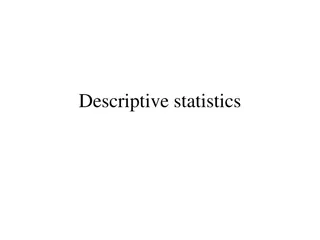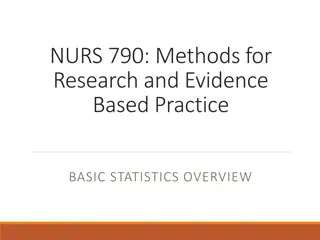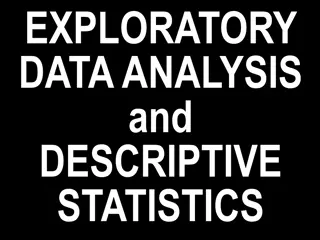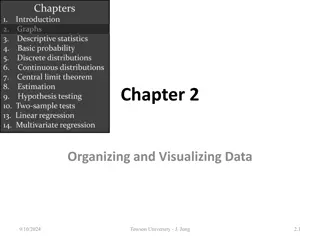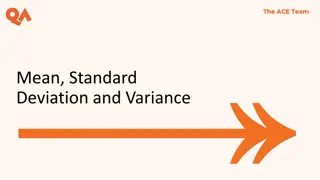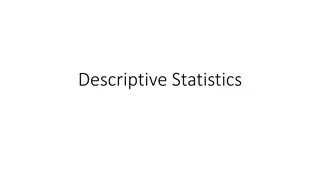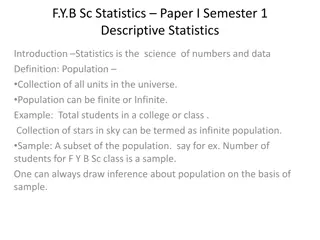Chapter 01 Descriptive Statistics
This chapter provides an introduction to descriptive statistics, covering basic concepts, sampling schemes, graphical representation of data, and numerical description of data. It also explores the role of computers in statistics. The chapter includes computer examples and projects for further practice.
Download Presentation

Please find below an Image/Link to download the presentation.
The content on the website is provided AS IS for your information and personal use only. It may not be sold, licensed, or shared on other websites without obtaining consent from the author.If you encounter any issues during the download, it is possible that the publisher has removed the file from their server.
You are allowed to download the files provided on this website for personal or commercial use, subject to the condition that they are used lawfully. All files are the property of their respective owners.
The content on the website is provided AS IS for your information and personal use only. It may not be sold, licensed, or shared on other websites without obtaining consent from the author.
E N D
Presentation Transcript
Chapter 01 Descriptive Statistics
CHAPTER CONTENTS Chapter 01 Descriptive Statistics 1.1 Introduction 1.2 Basic Concepts 1.3 Sampling Schemes 1.4 Graphical Representation of Data 1.5 Numerical Description of Data 1.6 Computers and Statistics 1.7 Chapter Summary 1.8 Computer Examples Projects for Chapter 1
1.1.1 DATA COLLECTION GENERAL PROCEDURE FOR DATA COLLECTION 1. Define the objectives of the problem Develop the experiment or survey. 2. Define the variables or parameters of interest. 3. Define the procedures of data collection Define the measuring techniques. This includes sampling procedures, sample size, and data-measuring devices (questionnaires, telephone interviews, etc.).
1.2 Basic Concepts Population vs sample Definition 1.2.1 A population is the collection or set of all objects or measurements that are of interest to the collector. EXAMPLE 1.2.1 Suppose we wish to study the heights of all female students at a certain university. The population will be (Pick one below.) (1) the set of all female students in the university (2) the set of the measured heights of all female students in the university What is the average height of all the males in Taiwan? The heights of all the males in Taiwan ---------- The population: The heights of 100 randomly picked males in Taiwan ----- This is a sample.
Definition 1.2.2 The sample is a subset of data selected from a population. The size of a sample is the number of elements in it. Examples of population & sample Political polls: The population = all the voters ~ 11,000,000 Taiwanese citizens A sample = a subset of voters we poll. ~ 1230 voters Laboratory experiment: The population = all the data we could have collected if we were to repeat the experiment a large number of times (infinite number of times) under the same conditions A sample = the data actually collected by an experiment. Quality control: The population = the entire batch of items produced, say, by a machine or by a plant A sample = a subset of items we tested. Clinical studies: The population = all the patients with the same disease A sample = the subset of patients used in the study 1000 patients: 700 recovered effective? Finance: The population = All common stock listed in stock exchanges such as the New York Stock Exchange, the American Stock Exchanges, and over-the-counter A sample = A collection of 20 randomly picked individual stocks from these exchanges
Descriptive vs Inferential statistics The average heights of this class = 168 cm and the stdev = 5 cm. Descriptive statistics Inferential statistics Organizing, summarizing, and presenting data in the form of tables, graphs, and charts Drawing inferences and making decisions about the population using the sample 100 males: 172 cm infer that the average male height in Taiwan = 172 cm. Question = What is the average height of all the males in Taiwan? Population: The heights of all the males in Taiwan A sample: 100 randomly picked males in Taiwan You measure the heights of 100 randomly picked males in Taiwan and take the average of them as the answer for the requested question. Ave. height of population = ave. height of the sample Definition 1.2.3 A statistical inference is an estimate, a prediction, a decision, or a generalization about the population based on information contained in a sample.
1.2.1 TYPES OF DATA Definition 1.2.4 Quantitative data: observations measured on a numerical scale. Height: 167 cm, 182 cm, Qualitative data (or categorical data) : Non numerical data that can only be classified into one of the groups of categories Nationality: Taiwan, Indonesia, USA, Example 1.2.3 Quantitative? Qualitative? Data on response to a particular therapy (classified as no improvement, partial improvement,or complete improvement) The number of minority-owned businesses in Florida The marital status of each person in a statistics class (as married or not married) The number of car accidents in different US cities v The blood group of each person in a community (as O, A, B, AB) v
Categorical data Nominal data Having data groups that do not have a specific order. Examples: state names, individuals s names Ordinal data Having data groups that should be listed in a specific order. The order may be either increasing or decreasing. Example: income levels. The data could have numeric values such as 1, 2, 3, or values such as high, medium, or low.
Definition 1.2.5 Cross-sectional data are data collected on different elements or variables at the same point in time or for the same period of time. Definition 1.2.6 Time series data are data collected on the same element or the same variable at different points in time or for different periods of time. Tainan Kaosiung Cross-sectional data Time series data Taoyuan
1.3 Sampling Schemes A census study ( ) the entire population is included in the study. Data are gathered on every member of the population. A representative sample accurately reflects its population characteristics. A biased sample not representative of the population characteristics The reliability or accuracy of conclusions drawn concerning a population depends on whether or not the sample is properly chosen so as to represent the population sufficiently well.
Simple random sampling Definition 1.3.1 (Simple random sampling) * A simple random sample A sample selected in such a way that every element of the population has an equal chance of being chosen * Equivalently each possible sample of size n has same chance of being selected as any other subset of sample of size n. Simple random sampling may not be effective in all situations. For example, in a US presidential election, it may be more appropriate to conduct sampling polls by state, rather than a nationwide random poll. It is quite possible for a candidate to get a majority of the popular vote nationwide and yet lose the election.
Systemtic sampling Source: http://blogs.lse.ac.uk/impactofsocialsciences/files/20 15/03/Systematic_sampling.jpg Definition 1.3.2 (Systematic sampling) A systematic sample is a sample in which every Kth element in the sampling frame is selected after a suitable random start for the first element. We list the population elements in some order (say alphabetical) and choose the desired sampling fraction.
Stratified sampling stratify = divide into nonoverlapping groups Source: http://www.mathcaptain.com/stat istics/stratified-sampling.html Definition 1.3.3 (Stratified sampling) * A sample obtained by stratifying (dividing into nonoverlapping groups) the sampling frame based on some factor or factors and then selecting some elements from each of the strata is called a stratified sample. * Here, a population with N elements is divided into s subpopulations. A sample is drawn from each subpopulation independently. The size of each subpopulation and sample sizes in each subpopulation may vary.
cluster sampling Source: https://www.youtube.com/wat ch?v=pV3FAVr086s The average height of university males in the US = ? One university = one cluster Definition 1.3.4 (cluster sampling) (also called area sampling) The sampling unit contains groups of elements called clusters instead of individual elements of the population. A cluster is an intact group naturally available in the field. Unlike the stratified sample where the strata are created by the researcher based on stratification variables, the clusters naturally exist and are not formed by the researcher for data collection.
Stratified Cluster Sampling Source: http://education-savvy.blogspot.tw/2016/01/types- of-probability-sampling.html Stratified Cluster Sampling: In order to minimize the occurrence of errors in cluster sampling, a new variety of cluster sampling has been introduced by combining stratified and cluster sampling which is called Stratified Cluster Sampling. In this kind of sampling, all the clusters having similar characteristics are stratified together and then at least one cluster is randomly selected from each stratum. After that either all or some elements of each selected cluster are sampled. (Source: http://education-savvy.blogspot.tw/2016/01/types-of-probability-sampling.html)
Multiphase sampling Definition 1.3.5 (Multiphase sampling) * involves collection of some information from the whole sample and additional information either at the same time or later from subsamples of the whole sample. * is basically a combination of the techniques presented earlier.
1.3.1 ERRORS IN SAMPLE DATA We are interested in the average test score in a large statistics class of size, say, 80 (= element no. of the population). A sample of size 10 (sample size) grades from this resulted in an average test score of 75. If the average test for the entire 80 students (the population) is 72, then the sampling error is 75 (sample average) 72(population average) = 3.
1.3.1 ERRORS IN SAMPLE DATA Nonsampling errors Sampling errors Description * occur in the collection, recording, and processing of sample data. * occur because the sample is not an exact representative of the population. * could occur as a result of bias in selection of elements of the sample, poorly designed survey questions, measurement and recording errors, incorrect responses, or no responses from individuals selected from the population * are due to the differences between the characteristics of the population and those of a sample from the population. Example For example, we are interested in the average test score in a large statistics class of size, say, 80 (= element no. of the population). A sample of size 10 (sample size) grades from this resulted in an average test score of 75. If the average test for the entire 80 students (the population) is 72, then the sampling error is 75 (samle average) 72(population average) = 3.
1.3.2 SAMPLE SIZE Male students in NCU = 6000 Sample size = ? 100? 200? 1000? > 1000? The sample size should depend on: the variation in the population the population size the required reliability of the results, that is, the amount of error that can be tolerated the available resources such as money and time
1.4 Graphical Representation of Data The most common graphical displays are the frequency table, pie chart, bar graph, Pareto chart, and histogram. The visual displays with charts or graphs may reveal the patterns of behavior of the variables.
Bar graph Definition 1.4.1 A graph of bars whose heights represent the frequencies (or relative frequencies) of respective categories is called a bar graph. EXAMPLE 1.4.1 The data in Table 1.5 represent the percentages of price increases of some consumer goods and services for the period December 1990 to December 2000 in a certain city. Construct a bar chart for these data. Table 1.5 Percentages of Price Increases of Some Consumer Goods and Services Medical Care Electricity Residential Rent Food Consumer Price Index Apparel & Upkeep 83.3% 22.1% 43.5% 41.1% 35.8% 21.2% Solution:
Pareto effect (or 80/20 rule) Vilfredo Pareto (1848-1923), an Italian economist and sociologist, studied the distributions of wealth in different countries. He concluded that about 20% of people controlled about 80% of a society s wealth. This same distribution has been observed in other areas such as quality improvement: 80% of problems usually stem from 20% of the causes. This phenomenon has been termed the Pareto effect or 80/20 rule. Pareto charts are used to display the Pareto principle, arranging data so that the few vital factors that are causing most of the problems reveal themselves. Focusing improvement efforts on these few causes will have a larger impact and be more cost effective than undirected efforts.
Pareto chart : A bar graph with the height of the bars proportional to the contribution of each factor. The bars are displayed from the most numerous category to the least numerous category. It is for a graphical representation of the relative importance of different factors. A Pareto chart helps in separating significantly few factors that have larger influence from the trivial many. EXAMPLE 1.4.2 For the data of Example 1.4.1, construct a Pareto chart. Solution: Medical Care Electricity Residential Rent Food Consumer Price Index Apparel & Upkeep 83.3% 22.1% 43.5% 41.1% 35.8% 21.2%
Pie chart Definition 1.4.2 A circle divided into sectors that represent the percentages of a population or a sample that belongs to different categories is called a pie chart. EXAMPLE 1.4.3 The combined percentages of carbon monoxide (CO) and ozone (O3) emissions from different sources are listed in Table 1.6. Construct a pie chart. Table 1.6 Combined Percentages of CO and O3 Emissions Transportation (T) 63% Industrial process (I) 10% Fuel combustion (F) 14% Solid waste (S) Miscellaneous (M) 8% 5% Solution
stem-and-leaf plot Definition 1.4.3 A stem-and-leaf plot is a simple way of summarizing quantitative data and is well suited to computer applications. When data sets are relatively small, stem-and-leaf plots are particularly useful. In a stem- and-leaf plot, each data value is split into a stem and a leaf. The leaf is usually the last digit of the number and the other digits to the left of the leaf form the stem. Usually there is no need to sort the leaves, although computer packages typically do. EXAMPLE 1.4.4 Construct a stem-and-leaf plot for the 20 test scores given below. 78 74 82 66 94 71 64 88 55 80 91 74 82 75 96 78 84 79 71 83 Solution
Frequency table A frequency table is a table that divides a data set into a suitable number of categories (classes). Rather than retaining the entire set of data in a display, a frequency table essentially provides only a count of those observations that are associated with each class. Grouped data data presented in the form of a frequency table class mark the center of each class. class boundaries the end points of each class interval
Definition 1.4.4 Let fidenote the frequency of the class i and let n be sum of all frequencies. The relative frequency for the class i = fi/n. The cumulative relative frequency for the class i = ?=1 ? ??/? EXAMPLE 1.4.5 The following data give the lifetime of 30 incandescent light bulbs (rounded to the nearest hour) of a particular type. Construct a frequency, relative frequency, and cumulative relative frequency table. 872 931 1146 1079 915 879 863 1112 979 1120 1150 987 958 1149 1057 1082 1053 1048 1118 1088 ( Lifetime of 30 bulbs ) 868 996 1102 1130 1002 990 1052 1116 1119 1028 Solution Note that there are n = 30 observations and that the largest observation is 1150 and the smallest one is 865 with a range of 285. We will choose six classes each with a length of 50. 850-900 850-900
Histogram Definition 1.4.5 A histogram is a graph in which classes are marked on the horizontal axis and either the frequencies, relative frequencies, or percentages are represented by the heights on the vertical axis. In a histogram, the bars are drawn adjacent to each other without any gaps.
EXAMPLE 1.4.6 The following data refer to a certain type of chemical impurity measured in parts per million in 25 drinking- water samples randomly collected from different areas of a county. 11 19 24 30 12 20 25 29 15 21 24 31 16 23 25 26 32 17 22 26 35 18 24 18 27 (a) Make a frequency table displaying class intervals, frequencies, relative frequencies, and percentages. (b) Construct a frequency histogram. Solution
11 19 24 30 12 20 25 29 15 21 24 31 16 23 25 26 32 17 22 26 35 18 24 18 27 8 7 6 5 4 3 2 1
1.5 Numerical Description of Data Data characteristics Measure Central tendency sample mean sample median Sample mode Dispersion or variability sample variance, sample standard deviation sample interquartile range
Definition 1.5.1 Let x1, x2, . . ., xn be a set of sample values. The sample mean (or empirical mean): The sample variance : The sample standard deviation :
Theorem 1.5.1 For a given set of measurements x1, x2, . . ., xn, let ? be the sample mean. Then
Definition 1.5.2 For a data set, the median is the middle number of the ordered data set. If the data set has an even number of elements, then the median is the average of the middle two numbers. The lower quartile is the middle number of the half of the data below the median. The upper quartile is the middle number of the half of the data above the median. Q3 = upper quartile Q2 = middle quartile (= M, median) Q1 = lower quartile Q3 Q2, Median Q1 Interquartile range (IQR) = (Q3 Q1)
Definition 1.5.3 Mode is the most frequently occurring member of the data set. If all the data values are different, then by definition, the data set has no mode. A mode indicates where the data tend to concentrate most. 31 4 18 23 28 9 6 28 12 28 17 23 32 Mode =
Trimmed mean Trimmed mean A robust measure of central location (a measure that is relatively unaffected by outliers) For 0 1, a 100 % trimmed mean is found as follows: Order the data; Discard the lowest 100 % and the highest 100 % of the data values; Find the mean of the rest of the data values. We denote the 100 % trimmed mean by X?
1.5.1 NUMERICAL MEASURES FOR GROUPED DATA Situation: Only the group data are available. There are no individual data values
EXAMPLE 1.5.4 The grouped data in Table 1.8 represent the number of children from birth through the end of the teenage years in a large apartment complex. Find the mean, variance, and standard deviation for these data: Here we use the usual convention of until the child attains next age, age will be the previous year, for instance until child is 4-year old, we will say child is 3-year old.
the median for the grouped data We will assume that the measures are spread evenly throughout this interval. Let Then the median for the grouped data is given by
All the numerical measures we calculate for grouped data are only approximations to the actual values of the ungrouped data if they are available.
Empirical Rule EMPIRICAL RULE When the histogram of a data set is bell-shaped or mound ( ) shaped, and symmetric, the empirical rule states: 1. Approximately 68% of the data are in the interval ( ? ?, ? + ?) 2. Approximately 95% of the data are in the interval ( ? 2?, ? + 2?) 3. Approximately 99.7% of the data are in the interval ( ? 3?, ? + 3?)
1.5.2 BOX PLOTS whiskers Source: http://indianapublicmedia.org/amomentofscience/why-whiskers/
The box plot (also called box-and-whisker plot) A pictorial summary to describe several prominent features of a data set such as the center, the spread, the extent and nature of any departure from symmetry, and identification of outliers. Box plots are a simple diagrammatic representation of the five number summary: maximum, upper quartile, median, lower quartile, minimum.



